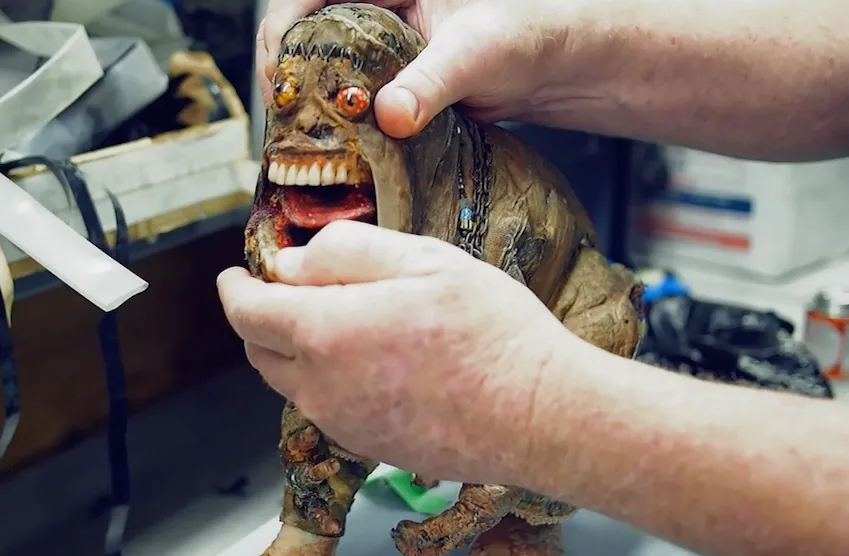Kaleidoscope’s recent showcase introduced me to the bizarre circus that is VR artistry
When I see the first ragged-looking creature I nearly jump out of my seat in surprise. I’ve never seen anything quite like it. It looks to have been made entirely out of moss, straw and dirt. Turning my head, another little gremlin pops into view and then another, and another, all of which are far too close to me for comfort. When my vision is swimming with dozens of the things I hear a loud trumpet blast. What looks to be a giant, clockwork monkey head emerges from a dark corner of the arena-like space. It screams and cackles before disappearing.
As the monkey retreats, a door on the other side of the arena begins to open and another creature – much larger and fouler than my little mossy friends – steps out. The thing is twice the size of the gremlins surrounding me, with a bulging head, hunched back, and tiny eyes. Its enormous mouth roars as it approaches me and I can see four appendages swinging just below its bulbous chin that are clearly meant to be breasts. Just before the monstrosity can take a bite out of me, we are both smashed to blackness by something fast and unseen to my left.
I remove the Oculus DK2 from my face feeling disturbed and a bit nauseous. Welcome to the strange and wonderful world of virtual reality art.
The experience I just described is titled Mad God and it seems to serve no purpose but to be strange. The roughly ten-minute experience took its creator, VFX guru Phil Tippett, six months to complete. Tippett’s original Mad God stop motion short was just as disturbing and it was transformed into an Oculus Rift experience by Tippet and Michael Breymamn – the co-founder of Kaleidoscope.
https://vimeo.com/155024150
Kaleidoscope was the organization throwing the event where Mad God was being demoed alongside a few dozen other VR experiences in the same vein. You won’t find Tilt Brush or Thunderbird at a show like this. This is a place for the strange, the experimental, and the downright confusing. This is a place to see a little virtual man pull confetti out of his butt and watch giants made of cubes walk around to an electronic dance beat. This is a place to get a taste of what art means in VR.
Kaleidoscope is a community and facilitator for independent VR creators, according to the group’s co-founder René Pinnell. He, along with his wife Selena- the festival’s creative director – and Breymann have been on a simple mission to unite and support the artistic creativity in the VR world for over two years now.
“At the end of the day why we exist is to support independent VR creators. We do that primarily by giving them exposure…Honestly, the folks who are making the most groundbreaking content are people that you’ve never heard of before,” Pinnell said.
Pinnell was able to detail some of these hidden gems for me, and also gave me a taste of what they are working on next:
Daniel Ernst: Creator of VR Dioramas such as Blocked In. His new work – Dear Pigeon Man is currently in development, according to Pinnet.
Tyler Hurd: The creator of Butts, a trippy experience that is about exactly what you think it is.His latest piece, a psychedelic animated dance routine called Old Friend will have its international premiere on the Vive through Kaleidoscope events.
Mike Tucker: Relatively unknown, Tucker is working on an experience entitled Tana Poura. The piece will be a collaboration with Jonny Greenwood from Radiohead, according to Pinnell.
Arjan Van Meerten: The creator of the well-loved Surge VR music video featuring marching giants made of cubes. Pinnell revealed that Kaleidoscope is working with Van Meerten on his next piece, Apex. The experience is expected to come out in 2-3 months and will follow Surge’s format of looped music combined with grandiose animation.
https://vimeo.com/151687862
Pinnell wants his shows to be packed with creators like these; people who are pushing the bounds of what it is possible to experience in VR.
“It’s more important who’s making these things and their intention behind it,” he said. “Mostly we care about finding projects with a unique point of view.”
Kaleidoscope does more than provide exposure for creative talents in VR. It also does its best to connect creators with funding sources. Pinnell estimates that it costs around $50,000 at minimum to create the type of short-form VR content he is displaying at this show. Kaleidoscope has so far managed to see four projects funded and is currently working on another six that Pinnell said would be announced in more detail soon. Kaleidoscope is a bootstrapped team of five people at this point and relies on sponsorships and ticket sales to facilitate its events.
This particular show – which took place at Google’s offices in Mountain View – was a dress rehearsal for the company’s upcoming world-tour. The show was put on in conjunction with Wired Magazine and sponsored primarily by Wevr, Nokia, and G Technologies. There were 50 Gear VR headsets, four Oculus DK2s and four Vives that were all eagerly engaged with by the nearly 400 guests in attendance.
VR artistry is strange, challenging, and a commercial nightmare. But, according to taste makers like Pinnell, that is exactly the way it should be.






























